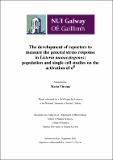| dc.description.abstract | The foodborne pathogen Listeria monocytogenes has a remarkable ability to persist and grow in harsh environments, including the human gastrointestinal tract. This attribute is regulated, at least partly, by the alternative stress-inducible sigma factor, sigma B (SigB). Although the SigB regulon is now well defined little is known about the way in which SigB activity is controlled in L. monocytogenes. In this study, the expression of genes that are known to be expressed in a SigB-dependent manner (opuCA, lmo2230, lmo2085, sigB) was measured with qRT-PCR in order to get insights into the conditions that trigger SigB activation as well as the kinetics. At the transcriptional level the osmotic stress-induced transcription of all four genes was dependent on the extent of the stress applied. During imposition of a sudden osmotic upshock the transcription of all four genes increased rapidly but transiently. To investigate SigB-dependent expression at the protein level polyclonal antibodies against OpuCA (compatible solute transporter) were developed in chickens and used in Western blotting. OpuCA was expressed in a growth phase dependent manner, with high levels of expression detected in stationary phase. In exponential phase expression levels were low but were induced under conditions of osmotic stress in a manner that was proportional to the magnitude of the stress. Furthermore, based on the transcriptional data, a fluorescent reporter fusion expressing EGFP from strongly SigB-dependent promoter was developed and introduced to L. monocytogenes EGD-e wild-type, delta_sigB and delta_rsbV. A comprehensive analysis of the SigB activation pattern during growth at 4°C and 37°C and induction in early exponential phase of growth followed by an increased SigB activity in stationary phase was revealed with flow cytometry at both temperatures. Interestingly, not all of the cells within the wt-egfp population were able to activate SigB above the highest autofluorescence level detectable by this reporter system. However, SigB activity can be induced further and proportionally to the extent of stress in exponential phase of growth at 37°C by exposure to osmotic stress. In summary, the data suggest that SigB activation is heterogeneous within population and can be rapidly modulated in a manner that is proportional to the magnitude of the stress encountered by L. monocytogenes. Overall, this study has given new insights into the regulation of a SigB-driven stress response in L. monocytogenes and mechanisms of its adaptability in response to stress. | en_US |


